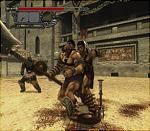The fighty bits are generally well done and to an extent meet the potential of the Gladiator end of the spectrum, but they still lack the spark of originality that could have given the whole game more life. The way in which you can look to the crowd for 'Salvos' (Latin for 'kudos') as you are performing your beastly battles is a nice twist, but it's under exploited. We would have welcomed a Tony Hawk's style points system, with proper strings and combos and specials and meters... but instead it leans more towards the button mashing style of play. And as the game expands, some of it gets plain silly - with some not entirely convincing arena obstacles and foes. But that's Capcom for you. Look away for a minute, and you just know someone's going to have fitted a monster in there somewhere.
Possibly the most interesting element of this gladiator battling is the central role of the weaponry. In most hackíníslashes, and indeed, most action adventure games, your weapon collections are your security blanket at the later, more difficult stages of the game. Once youíve unlocked that special rocket launcher, or found that legendary sword, you know youíll have the upper hand for the foreseeable future. In SoR, however, you might have the upper hand, but after beating it against an enemy, it will perish away to nothing. Eventually, your weapons blunt and crumble, leaving you in the proverbial without even a paddle, let alone a massive great ball-and-chain mace. This keeps the panic levels good and high, makes the fights all the more frenetic and gives the game a slight survival horror feel in its more testing moments. And on that front, itís a case of well done Capcom.
Agrippa (Latin for 'John') and Octavianus (Latin for 'Jeremy'?) deal with the gladiator and stealth bits respectively. As lead characters, they're as well designed and nicely represented as you'd expect from a game this late in the PS2's life; but as soon as you meet the floppy haired youth, it's clear that Octavianus and his stealth sections are the game's Achillesí heel (Latin for 'weak point'). It was these portions of the game that had the scope to lead you through the shadowed alleys of ancient Rome and immerse you in the story, but these stages are all too shallow. The pale concession to a bit of RPG/explorative value is the fact that there are shops, but you can't buy broiled Swan liver stuffed in doormouse heads and you can't buy Amazonian slaves [maybe not surprising since South America not discovered at the time, try Athenian Slaves - Ed]; so frankly, we weren't all that impressed.
Possibly the most interesting element of this gladiator battling is the central role of the weaponry. In most hackíníslashes, and indeed, most action adventure games, your weapon collections are your security blanket at the later, more difficult stages of the game. Once youíve unlocked that special rocket launcher, or found that legendary sword, you know youíll have the upper hand for the foreseeable future. In SoR, however, you might have the upper hand, but after beating it against an enemy, it will perish away to nothing. Eventually, your weapons blunt and crumble, leaving you in the proverbial without even a paddle, let alone a massive great ball-and-chain mace. This keeps the panic levels good and high, makes the fights all the more frenetic and gives the game a slight survival horror feel in its more testing moments. And on that front, itís a case of well done Capcom.
Agrippa (Latin for 'John') and Octavianus (Latin for 'Jeremy'?) deal with the gladiator and stealth bits respectively. As lead characters, they're as well designed and nicely represented as you'd expect from a game this late in the PS2's life; but as soon as you meet the floppy haired youth, it's clear that Octavianus and his stealth sections are the game's Achillesí heel (Latin for 'weak point'). It was these portions of the game that had the scope to lead you through the shadowed alleys of ancient Rome and immerse you in the story, but these stages are all too shallow. The pale concession to a bit of RPG/explorative value is the fact that there are shops, but you can't buy broiled Swan liver stuffed in doormouse heads and you can't buy Amazonian slaves [maybe not surprising since South America not discovered at the time, try Athenian Slaves - Ed]; so frankly, we weren't all that impressed.
Read More Like This
Comments
I agree with you that the stealth parts are uninspiring. That said, the ultraviolent arena fighting made up for it, at least for me. getting chased round the arena till you can get a weapon then going back and wreaking bloody vengeance was incredibly satisfying.
Hah, not so smart now I've chopped your arms off, are ya?
Hah, not so smart now I've chopped your arms off, are ya?




